Abstract
The existence mode of Y is an important factor affecting the oxidation resistance of NiCrAlY coating. The traditional thermal sprayed NiCrAlY coating had some problems such as internal-stress-induced coating peeling, when it was used at high temperature for a long time. In this paper, Y-modified NiCrAlY coatings were prepared on the surface of thermal-sprayed NiCrAlY coatings by halide-activated pack-cementation technology. The microstructure and oxidation resistance of the coatings after thermal insulation at 1100 °C for 100 h were analyzed. The results show that the oxidation resistance of Y-modified NiCrAlY coatings was improved significantly. When the oxidation temperature and time were 1100 °C and 100 h, the oxidation weight gain of thermal sprayed NiCrAl0.5Y and NiCrAl1.0Y coatings was 3.8 and 2.2 times that of Y-modified coatings, respectively. In addition, the NiCrAlY coatings prepared by pack cementation had better oxidation resistance than thermal sprayed coatings when the content of Y was equal. The oxidation resistance of the pack-cemented NiCrAlY coatings were increased with the increase in Y content when it was in a range of 0~1 wt.%. When oxidized at 1100 °C for 100 h, the oxidation weight gain of the pack-cemented NiCrAl0.5Y and NiCrAl1.0Y coatings was about 1.8 and 0.9 mg/cm2, respectively. The formation of highly stable intermetallic compounds Ni5Y in the pack-cemented Y-modified coatings is concluded to be the reason for improving the oxidation resistance of the coatings. This work can provide a solution to improve the oxidation resistance of traditional MCrAlY coatings.
1. Introduction
Nickel-base alloys are widely used in the manufacture of hot end components, such as various engine blades and turbine blades, because of their excellent comprehensive properties [1,2]. The hot end components are exposed to high-temperature environments for a long time, and the complex hot-corrosion conditions will lead to serious oxidation of the components, thus reducing the service performance and service life of the alloy. The alloy parts with poor oxidation resistance will inevitably waste resources due to their short life, which will increase their maintenance cost to a certain extent. In order to ensure the long-term and stable operation of mechanical equipment, it is one of the effective measures to improve the life and reliability of hot end components to prepare a certain thickness of high-temperature protective coating on the alloy surface by physical and chemical methods. At present, many thermal protection coatings have been developed and applied for different service conditions [3,4]. Preparation of coatings is one of the key high-temperature protection technologies in aerospace, shipping, and other fields. However, there are still many bottleneck technologies to be solved in terms of reducing material costs, improving service performance, and extending the service life of coatings.
MCrAlY (M = Ni, Co) coating is one of the most promising thermal barrier coatings for advanced gas turbines [5], but it still faces challenges of higher temperature tolerance, longer service life and higher reliability. In the process of high-temperature service, due to the thermal-stress mismatch between the alloy coating and oxide film, the oxide film peeling off from the alloy substrate is the root cause of coating failure. The active element Y in the alloy can significantly enhance the adhesion between the alloy and the oxide film [6,7]. The high-temperature oxidation resistance of the MCrAlY coating is significantly improved and its service life is extended through the “positive grain boundary effect”. However, with the in-depth study of the MCrAlY coating, researchers found that under the conditions of high Y content or long service at 1100 °C, the Y2O3 will further generate Y-Al-O complex oxides such as AlYO3 (Yttrium Aluminum Perovskite, YAP) and Al5Y3O12 (Yttrium Aluminum Garnet, YAG) [8]. The phase-change stress generated in the coating and the promotion of O diffusion will cause oxide-film cracking and serious internal oxidation [9,10], and the effect of this phenomenon on the coating performance is more significant with an increase in Y content, service temperature or service time. C. Serrano Vergel et al. [11] accelerated the oxidation of NiCoCrAlY at 900~1200 °C in a pure-O2 environment. The results showed that when the temperature was higher than 1100 °C, obvious Y-Al-O oxides appeared in the coating, and the content of Y in the oxide film increased significantly with the increase in temperature and time, which led to the cracking of the oxide film and failure. Therefore, how to control the mass oxidation of Y in the MCrAlY coating and inhibit the failure of Y during long-term service at high temperature are the key issues of current research.
The high-temperature thermal stability of MCrAlY coatings can be significantly improved by the presence of Y in the form of highly stable intermetallic compounds [12,13]. M. Subanovic et al. [14] showed that Y in MCrA1Y existed in the form of the highly stable Anderson-structure intermetallic compound M5Y, which has better high-temperature stability and oxidation resistance than Y. J. Toscano et al. [15] studied the effect of MCrA1Y on the cycle life of a thermal-growth oxide layer, which also showed that Y existed in the coating as an intermetallic compound, which can avoid the rapid oxidation of Y, significantly reduce the impact of Y-Al-O complex oxides on the coating performance, and improve the thermal stability of the coating. H. Lau et al. [16] revealed that NiXY had a great influence on the thickness of the thermal-growth oxide layer, and the nano NiY was characterized and analyzed by scanning transmission electron microscope. Therefore, obtaining intermetallic compounds with high-stability Y is the key to improving the high-temperature thermal stability of the MCrAlY coating. The experimental results of A. Gil et al. [17,18] can show that Y has been oxidized to form Y-Al-O oxides such as YAP in the vacuum milling process of MCrAlY, and retained in the coating through a “genetic effect”. Therefore, using the traditional method of adding the element Y to the alloying process, Y in the coating mainly exists in the form of oxide, and Y containing intermetallic compounds cannot be obtained.
Diffusion permeation is an in-situ chemical-vapor deposition technology. The active atoms that produce the permeated elements at high temperatures can directly react with the matrix to form intermetallic compounds [19]. To sum up, in order to directly bond atomic [Y] with a NiCrA1Y matrix element and generate Y containing intermetallic compounds at grain boundary, this paper adopted the powder-pack-cementation method to permeate Y on the surface of a thermal-sprayed NiCrAlY coating based on diffusion-permeation technology. The microstructure and oxidation resistance of thermal-sprayed NiCrAlY and thermal-sprayed, pack-cemented Y-modified NiCrAlY coatings under different Y-content conditions were compared and analyzed. The oxidation resistance mechanism of the Y-modified coating was discussed in combination with the pack cementation process principle and the coating oxidation dynamic curve, hoping to provide a reference for the application and development of the NiCrAlY coating.
2. Materials and Methods
2.1. Preparation of Coatings
NiCrAlY alloy powder was prepared by vacuum smelting and gas atomization, with atomization pressure of 2.2 MPa. Three groups of Ni22Cr8Al0.0Y, Ni22Cr8Al0.5Y and Ni22Cr8Al1.0Y (wt.%, the same below) coatings with different Y contents were prepared by low-pressure plasma spraying (BRGIMM, Beijing, China), and the spraying power was 80 kW. The NiCrAl-coating block samples with a dimension of 10 mm × 10 mm × 2 mm were used as the pack-cemented matrix material based on wire-electrode cutting method. The surface of the matrix was polished with 180~1500 mesh SiC sandpaper, in turn, and then cleaned with ultrasonic for 15 min and dried.
The diffusion-permeation process adopts the pack-cementation method. The composition of the pack consists of 5 wt.% Y2O3 agent, 87 wt.% Al2O3 filler and 8 wt.% NaF catalyst (Beijing Tong Guang Fine Chemicals Company, Beijing, China). The specific preparation method of pack-cemented Y-modified NiCrAlY coatings was as follows: Firstly, we mixed the powder of the permeated agent in a drum type ball mill with a rotating speed of 320 r/min, and the ratio of ball to material was 10:1; we put the matrix block with clean surface treatment into the crucible, then compacted and sealed it with penetrant powder and high-temperature binder, respectively; we put the crucible into the vacuum atmosphere tube furnace (SAF Therm, Luoyang, China) using the vacuum pump to conduct vacuum pumping treatment three times, and then filled the argon with purity of 99.9 %; we set the program to start heating with a heating rate of 10 °C/min when the temperature was below 800 °C, and 5 °C/min when the temperature was above 800 °C; the sample was cooled in the furnace and ultrasonically cleaned for 15 min after pack cementation. Based on the previous exploration of thermal diffusion-permeation process, the pack-cementation temperature and holding time were determined to be 1150 °C and 6 h, respectively. Schematic diagram of pack-cementation process is shown in Figure 1.
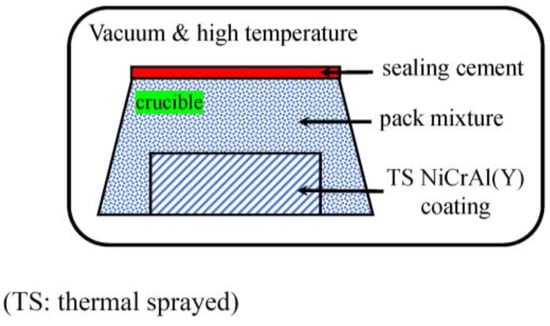
Figure 1.
Schematic diagram of pack cementation.
2.2. Oxidation Resistance Test and Characterization
The high-temperature thermogravimetric analyzer (TGA, Setsys evo, Lyon, France) was used to conduct the constant-temperature oxidation test of Y-modified coatings at 1100 °C for 100 h. The oxidation kinetics curve of Y-modified coatings was calculated based on the sample mass-change data. Similarly, vacuum tube resistance furnace (STG-100-14, SAF Therm, Luoyang, China) was used to conduct the constant-temperature oxidation test of the original thermal-sprayed NiCrAlY coatings at 1100 °C for 100 h. Samples were taken and weighed every 10 h. The oxidation resistance of the thermal-sprayed coatings was compared with that of the Y-modified coatings based on the weight gain per unit area, as shown in Equation (1):
where is the weight gain per unit area, is the mass after oxidation, is the mass before oxidation, and is the surface area of the sample. The microstructure and chemical-element distribution of the coating were characterized by scanning electron microscopy (SEM, Carl Zeiss, Oberkochen, Germany) equipped with energy dispersive spectrometer (EDS, Bruker, Bielerika, MA, USA). In addition, in order to further characterize the element distribution at the grain boundary of the diffusion layer, focused ion beam and scanning transmission electron microscope (S-TEM, Hitachi S-5500, HITACHI, Tokyo, Japan) were used to prepare the diffusion-layer samples and conduct energy-spectrum analysis, respectively. The hardness of the coatings was measured with a Vickers hardness tester (Wilson VH3300, Buehler, Lake Bluff, IL, USA), the selected hardness scale was HV0.3. The loading force and the holding time were 300 gf and 10 s, respectively. The hardness of Y-modified NiCrAlY coatings was in a range of 380~450 HV0.3. The phase of the coatings was characterized by X-ray diffraction (XRD, Rigaku, Tokyo, Japan). Schematic diagram of research route is shown in Figure 2.

Figure 2.
Schematic diagram of research route.
3. Results and Discussion
3.1. Oxidation Behavior of TS NiCrAlY Coatings
Figure 3 shows the sectional micromorphology of thermal-sprayed (TS) NiCrAl, NiCrAl0.5Y and NiCrAl1.0Y coatings after oxidation at 1100 °C for 100 h. Figure 4 shows the element distribution of the TS NiCrAl0.5Y coating after oxidation at 1100 °C for 100 h. Obvious oxide layers were formed on the surfaces of the three groups of coatings. It can be seen from Figure 3a that the interface between the oxide film on the surface of the NiCrAl coating and the coating substrate has many cracks, causing the oxide film to fall off, which is not conducive to the protection of the coating substrate. It can be seen from Figure 3b,c and Figure 4 that a typical layer of Al2O3 oxide film was formed on the surface of NiCrAl0.5Y and NiCrAl1.0Y coatings by comparing with previous research results [20,21]. The film is continuous and grows towards the interior of the coating, producing a good bonding effect with the coating substrate.
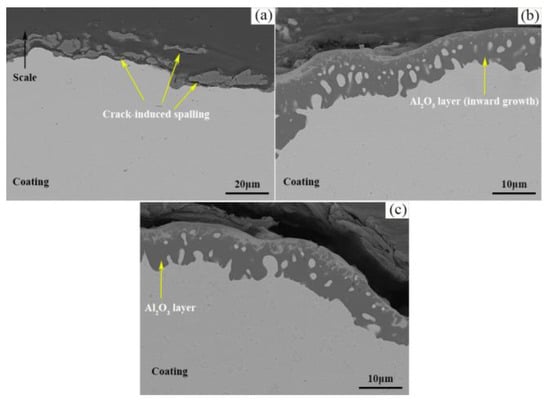
Figure 3.
SEM images of TS (a) NiCrAl; (b) NiCrAl0.5Y and (c) NiCrAl1.0Y coatings after oxidation at 1100 °C for 100 h.
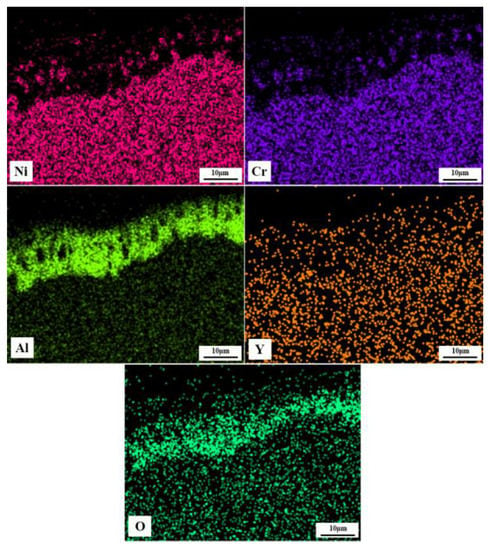
Figure 4.
Elements distribution of TS NiCrAl0.5Y coating after oxidation at 1100 °C for 100 h.
Figure 5 shows the phase composition of the Y-modified NiCrAlY coating. XRD analysis shows that the NiCrAlY coating was mainly composed of Ni, Ni3Al and NiAl. To evaluate the oxidation resistance of TS coatings, the oxidation dynamic curves of TS NiCrAl, NiCrAl0.5Y and NiCrAl1.0Y coatings after oxidation at 1100 °C for 100 h are shown in Figure 6. It can be seen from Figure 6 that when the time is 0~10 h at the initial stage of oxidation, the three groups of coatings have obvious oxidation weight gain, indicating that the coating was rapidly oxidized at this time. The TS NiCrAl coating with the maximum oxidation weight gain per unit area was 2.25 mg/cm2 and the TS NiCrAl0.5Y coating with the minimum oxidation weight gain per unit area was 1.71 mg/cm2 when the oxidation time was 10 h. A large amount of Al in the coating substrate diffuses outward and combines with O to form an Al2O3 film with poor adhesion when the oxidation time is more than 20 h. Due to the large difference in the thermal-expansion coefficient between the oxide layer on the NiCrAl coating surface and the coating substrate, cracks were generated under the effect of thermal mismatch stress, which causes the oxide layer to fall off (as shown in Figure 3a). Two phenomena, consisting of scale peeling and further oxidation inside the coating, are generated simultaneously, so the oxidation weight gain of the TS NiCrAl coating tends to decrease.
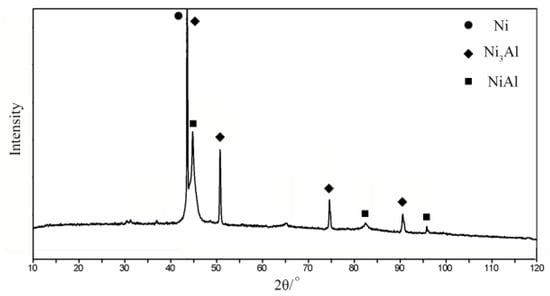
Figure 5.
XRD pattern of the Y-modified NiCrAlY coating.
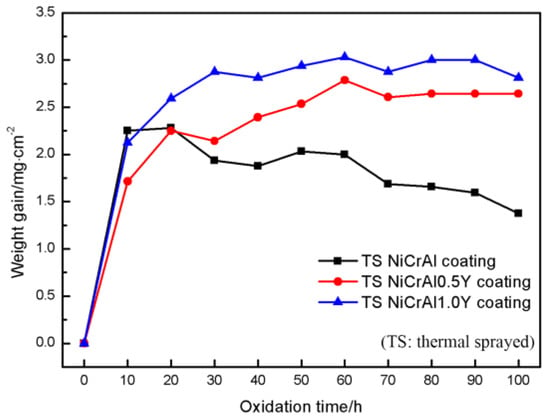
Figure 6.
Weight gain curve of TS coatings during constant oxidation at 1100 °C for 100 h.
In addition, when the oxidation time is 20~100 h, because the element Y was added to the NiCrAl0.5Y and NiCrAl1.0Y coatings, the formation enthalpy of Y is lower than that of Al, Cr and O, and Y is preferentially oxidized to form Y2O3 at high temperature, which is enriched at the interface between oxide film and alloy substrate. The bonding strength of Al2O3 film and coating substrate can be significantly enhanced by refining Al2O3 grains and pinning. At the same time, the diffusion rate of metal cations Al3+ and Cr3+ can be reduced based on the “positive grain boundary effect” [19], so the oxide film on the surface of these two groups of coatings did not fall off easily, and the oxidation weight gain per unit area increased with time, significantly increasing the oxidation resistance of the coatings. However, too-high Y content will lead to the formation of Y-Al-O complex oxides after high-temperature oxidation of the coating, reducing the thermal stability of the coating. Therefore, it can be concluded from Figure 6 that the NiCrAl0.5Y coating has the best oxidation resistance among the three groups of thermal-sprayed coatings.
3.2. Oxidation Behavior of TS-PC Y-modified NiCrAlY Coatings
Figure 7 shows the sectional micro morphology of Y-modified NiCrAl, NiCrAl0.5Y and NiCrAl1.0Y coatings prepared by powder-pack-cementation technology after oxidation for 100 h at 1100 °C. It can be seen from Figure 7a that a discontinuous Al2O3 oxide film was formed on the surface of the pack-cemented (TS-PC) Y-modified thermal-sprayed NiCrAl coating after oxidation, and a few cracks were still generated at the interface, but the coating-peeling phenomenon was obviously alleviated, and the coating was not completely peeling off. It can be seen from Figure 7b that a very dense and continuous protective film of oxide layer was formed on the surface of Y-modified NiCrAl0.5Y coating after oxidation, and the thickness was uniform with a thickness of about 5 μm. The interface between the oxide film and the coating substrate was smooth and continuous, which can predict its excellent oxidation resistance. On the contrary, it can be seen from Figure 7c that although a relatively continuous oxide layer was also produced on the surface of the Y-modified NiCrAl1.0Y coating, its thickness was evenly distributed, up to 15 μm, and many irregular granular internal oxides were produced in the coating, which leads to a reduction in its thermal stability.
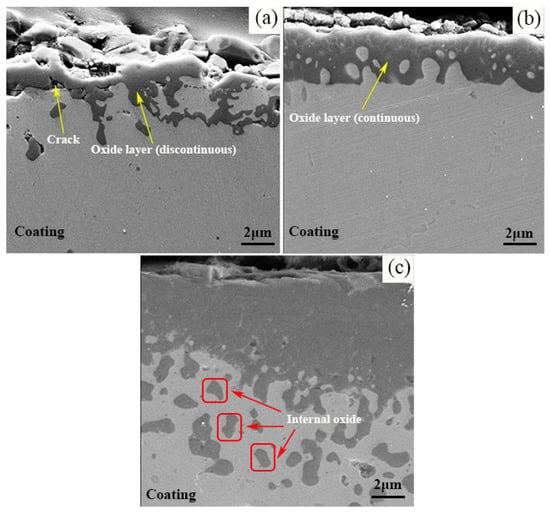
Figure 7.
SEM images of TS-PC Y-modified (a) NiCrAl; (b) NiCrAl0.5Y and (c) NiCrAl1.0Y coatings after oxidation at 1100 °C for 100 h.
Figure 8 shows the weight-gain curve of the TS-PC Y-modified coatings oxidized at 1100 °C for 100 h at constant temperature. It can be seen from Figure 8 that the oxidation weight gain of the three groups of Y-modified coatings increased with the extension of oxidation time when it is in a range of 0~100 h. Among them, the initial oxidation period of 0~10 h is still the stage when the oxidation weight gain of the coating is significantly increased. The oxidation weight gain per unit area of TS-PC Y-modified NiCrAl, NiCrAl0.5Y and NiCrAl1.0Y coatings is 2.02, 0.55 and 0.84 mg/cm2, respectively. When the oxidation time is 20~100 h, the oxidation weight gain of the three groups of coatings increased slowly. After 100 h of oxidation, the oxidation weight gain of the three groups of coatings increased to 2.18, 0.69 and 1.28 mg/cm2, respectively. The TS-PC Y-modified NiCrAl0.5Y coating shows the best oxidation resistance at the lowest oxidation weight-gain level all the time, showing an obvious structure-activity relationship with the microstructure in Figure 7.
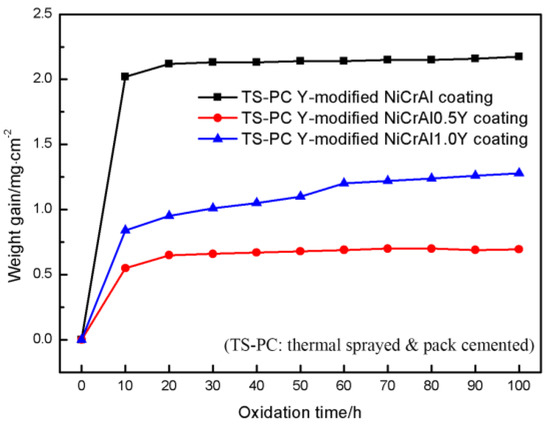
Figure 8.
Weight-gain curve of TS-PC Y-modified coatings during constant oxidation at 1100 °C for 100 h.
3.3. Comparison of Oxidation Resistance of Coatings and Y-modifying Mechanisms
In order to compare the oxidation resistance of the coating before and after TS-PC Y-modification, the oxidation dynamic comparison curves of the coatings after oxidation at 1100 °C for 100 h were obtained, as shown in Figure 9. When the oxidation time is 10~100 h, the coating oxidation weight gain and time show a parabola law; the fitting curves are shown in Figure 10, and the fitting equations are:
where y is the oxidation weight gain per unit area of the coating, and t is the oxidation time at 1100 °C (10 h ≤ t ≤ 100 h). From the below Equations, the oxidation weight gain of all coatings except TS NiCrAl increases with the extension of oxidation time.
y = −0.0089t + 2.35833 (TS NiCrAl)
y = 0.00879t + 1.95238 (TS NiCrAl0.5Y)
y = 0.00602t + 2.475 (TS NiCrAl1.0Y)
y = 0.00111t + 2.07033 (TS-PC NiCrAl)
y = 0.00114t + 0.60567 (TS-PC NiCrAl0.5Y)
y = 0.00478t + 0.852 (TS-PC NiCrAl1.0Y)
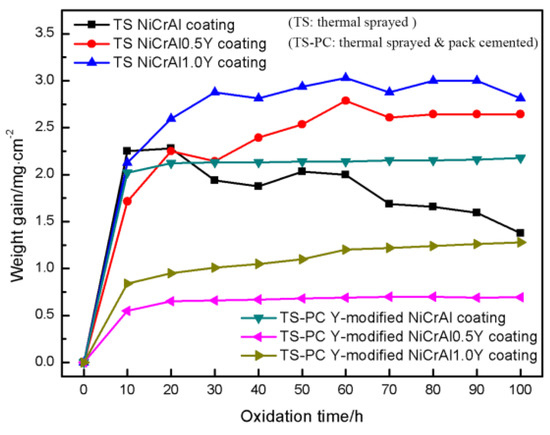
Figure 9.
Comparison of oxidation weight gain between TS and TS-PC Y-modified coatings.

Figure 10.
Fitting curve of coating oxidation weight gain when oxidation time is 10~100 h.
For the NiCrAl coating prepared by thermal spraying, the Al element diffuses outward and forms an aluminum oxide film with O element after high-temperature oxidation. The diffusion speed of O element in the coating is large. Long-time oxidation will cause the complete consumption of Al atoms in the coating matrix, which will lead to the continuous accumulation of aluminum-oxide film thickness, and the coating will splash or peel off under the effect of internal stress. Currently, the interior of the coating further contacts with the outside air, resulting in its continuous oxidation. Therefore, the oxidation weight gain of the thermal-sprayed NiCrAl coating is affected by the splash of oxide scale and the formation of Al2O3 film, which leads to the downward trend of its oxidation weight gain with poor oxidation resistance, as shown in Equation (2).
The Y2O3 thin film generated during the oxidation process of thermal-sprayed coatings containing Y can improve the oxidation resistance of the coatings. However, Y2O3 will further generate complex oxides such as YAP and YAG with the increase in Y content and the extension of the high-temperature service time of the coatings. Under the dual mechanism of phase-change stress and the promotion of O diffusion, the coating is prone to crack initiation and propagation, which leads to further oxidation inside the coating. Meanwhile, the research shows that Y is significantly oxidized at 1000 °C when the O partial pressure is 10−5 mbar [17,18], that is, some Y is oxidized to form oxides in the vacuum milling process of NiCrAlY, and retained in the coating through the “genetic effect”. Therefore, the higher the Y content, the lower the thermal stability of the thermal-sprayed NiCrAlY coating, as shown in Equation (4).
In addition, it can be seen from Figure 9 that compared with the thermal-sprayed coatings with the same composition, the oxidation weight gain per unit area of the Y-modified coatings decreased significantly. The oxidation resistance of Y-modified NiCrAl coating is the worst among the three groups of modified coatings. Although Y is permeated into the coating, the amount of Y permeated into the NiCrAl coating after the pack-cementation treatment is relatively limited. The permeated Y only gathers on the surface of the coating matrix and is unevenly distributed, resulting in limited improvement of its oxidation resistance. When the oxidation temperature and time are 1100 °C and 100 h, respectively, the oxidation weight gain of thermal sprayed NiCrAl0.5Y coating is 3.8 times that of Y-modified NiCrAl0.5Y coating, and the oxidation weight gain of thermal sprayed NiCrAl1.0Y coating is 2.2 times that of Y-modified NiCrAl1.0Y coating. It is the core reason to improve the high-temperature and spalling resistance of the NiCrAlY coating via permeating Y to change the diffusion mechanism of Al and O, thereby improving the adhesion of Al2O3 film [21].
The improvement in the oxidation resistance of the coating is closely related to the modification mechanism of Y in the coating. Under high-temperature reaction conditions, with the addition of Y2O3 and NaF powder in the penetrant, Y2O3 reacts with the catalyst NaF to generate YFx under certain conditions as rare-earth element Y is a typical highly reactive element. YFx diffuses to the matrix under the effect of concentration gradient, and reacts with the matrix surface to form the active atom [Y] of the permeated element through phase interfaces such as decomposition or replacement. Under the effect of diffusion permeation, the atomic state [Y] directly bonds with the NiCrAl matrix element, and a stable intermetallic compound is generated at the grain boundary to obtain a Y-modified coating. The possible reactions during this process are as follows:
Y2O3 (s) + NaF (l) → YFx (g) + Na (g) + O2 (g)
YFx (g) → [Y] + F2 (g)
[Y] + Ni (s) → NixY (s)
Figure 11 shows the S-TEM image and element distribution of the Y-modified NiCrAlY coating. It can be seen from Figure 11 that Y is enriched around the grain boundary in the modified coating. Two points, 1 and 2, with obvious enrichment were selected and EDS element analysis was carried out. The result shows that the element ratio of Ni to Y is about 5, which indicates that the diffusion permeating Y mostly exists at the grain boundary in the form of Ni5Y. The modification mechanism of Y is shown in Figure 12. After high-temperature oxidation, the modified coating can form a relatively dense and uniform Al2O3 film on its surface. The active element Y permeated into the coating matrix can effectively inhibit the diffusion of Al to the coating surface, make the oxide film grow inward and improve the bonding strength between the oxide film and the substrate. Meanwhile, the stability of Y containing intermetallic Ni5Y is better, extending the time for Y to generate Y-Al-O oxides. Thus, the high-temperature oxidation resistance of the original thermal-sprayed NiCrAlY coatings was improved. At the same time, the hardness of the coating matrix was improved after Y permeation, which indicates that the internal bonding strength of the coating was improved accordingly, which makes the coating less prone to crack initiation and failure. Therefore, the changes in coating hardness and microstructure further improve the oxidation resistance of the coating.
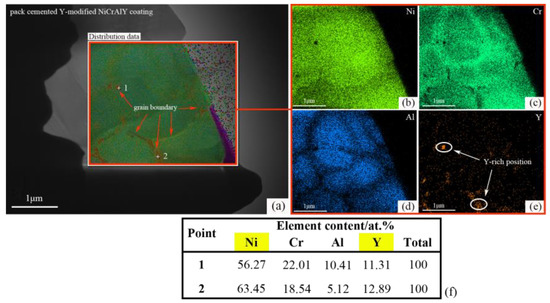
Figure 11.
(a) S-TEM micrograph of pack-cemented Y-modified NiCrAlY coating, element distribution of (b) Ni; (c) Cr; (d) Al; (e) Y and (f) element contents in points 1 and 2.

Figure 12.
Schematic diagram of Y-modification mechanism.
In addition, when the pack-cemented matrix is a thermally sprayed NiCrAl1.0Y coating, there are still Y2O3 and other oxides in the initial state coating due to high Y content. The diffusion rate of O in Y2O3 is large, such as 2.2 × 10−11 cm2/s at 700 °C [10], so high Y content in a thermal-sprayed coating matrix will aggravate coating oxidation, which leads to the oxidation resistance of Y-modified NiCrAl0.5Y coating being better than that of the Y-modified NiCrAl1.0Y coating. Therefore, in order to compare the oxidation resistance of the pack-cemented coating and thermal-sprayed coating, the oxidation resistance of the thermal-sprayed and pack-cemented coatings under the same amount of Y was also studied, and its comparative oxidation dynamic curve is shown in Figure 13. It can be seen from Figure 13 that under the condition of containing the same amount of Y, the pack-cemented coatings have better oxidation resistance than the thermal-sprayed coatings at a lower oxidation weight gain. The oxidation resistance of the pack-cemented coating is further improved with the increase in the amount of Y. The results show that the pack-cemented NiCrAl1.0Y coating shows the best oxidation resistance. When the coating was oxidized at 1100 °C for 100 h, the oxidation weight gain of the pack-cemented NiCrAl0.5Y and NiCrAl1.0Y coatings was about 1.8 and 0.9 mg/cm2, respectively.
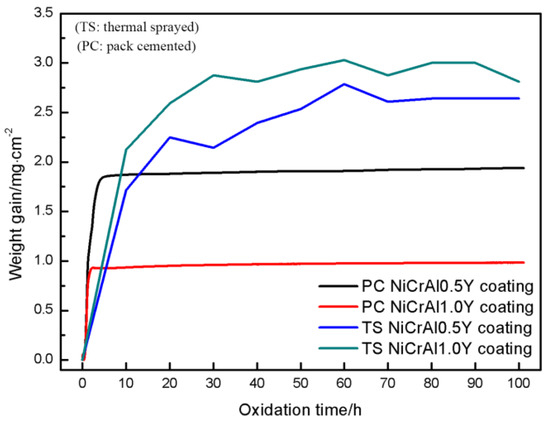
Figure 13.
Oxidation resistance comparison of TS and PC NiCrAlY coatings with equal amount of Y.
4. Conclusions
In this work, the intermetallic compound Ni5Y-modified NiCrAlY coating was successfully prepared by pack cementation. The oxidation resistance of TS NiCrAlY coatings and Y-modified coatings was compared and analyzed, and the influence of the existence mode of Y on the oxidation resistance of the coatings was discussed. However, the existing pack-cementation technology is still not able to control the amount of Y, so optimizing the pack-cementation process to obtain high stable content Y-modified coating is the next research focus. The main conclusions of this paper are as follows:
- (1)
- The Al2O3 oxide film formed on the surface inhibits the further diffusion of O, and is the main oxidation resistance mechanism of NiCrAlY coating. A lot of cracks generated on the interface between Al2O3 oxide film and TS NiCrAl coating substrate due to the mismatch of the thermal and physical properties of the two, which resulted in the oxide scale falling off, and resulted in the worst oxidation resistance. The existence of Y can improve the adhesion of the oxide film and inhibit the diffusion of Al3+. However, excessive Y content will lead to the formation of complex oxides such as Y-Al-O at high temperatures, which will reduce the thermal stability of the coating under the effect of phase-change stress.
- (2)
- The oxidation resistance can be significantly improved by permeating Y into the matrix of the TS NiCrAlY coatings. The intermetallic compound Ni5Y in the TS-PC Y-modified coating is more stable, which can prolong the time for Y to generate Y-Al-O and other complex oxides. When the oxidation time at 1100 °C was 100 h, the oxidation weight gain of TS NiCrAl0.5Y and TS NiCrAl1.0Y coatings was 3.8 times and 2.2 times that of TS-PC Y-modified coatings, respectively.
- (3)
- Under the condition of containing the same amount of Y, the pack-cemented NiCrAlY coating has better oxidation resistance and hardness than the thermal-sprayed NiCrAlY coating. The oxidation resistance of the pack-cemented NiCrAlY coatings increases with the increase in Y content when it is in a range of 0~1 wt.%. When the coating was oxidized at 1100 °C for 100 h, the oxidation weight gain of the pack-cemented NiCrAl0.5Y and NiCrAl1.0Y coatings was about 1.8 and 0.9 mg/cm2, respectively.
Author Contributions
Conceptualization, S.Z. and H.Y.; methodology, S.Z., P.O. and L.S.; investigation, S.Z., P.O., H.Y. and L.S.; formal analysis, S.Z.; data curation, S.Z.; writing—original draft preparation, S.Z.; writing—review and editing, P.O.; supervision, S.Z. and L.S.; funding acquisition, S.Z. All authors have read and agreed to the published version of the manuscript.
Funding
This research was funded by Jointly Funded Project of Beijing Municipal Education Commission and Beijing Municipal Natural Science Foundation (grant no. KZ201910009010) and Natural Science Foundation of Beijing (grant no. 3212003).
Institutional Review Board Statement
Not applicable.
Informed Consent Statement
Not applicable.
Data Availability Statement
Not applicable.
Conflicts of Interest
The authors declare no conflict of interest.
References
- Koo, C.H.; Bai, C.Y.; Luo, Y.J. The structure and high temperature corrosion behavior of pack aluminized coatings on superalloy IN-738LC. Mater. Chem. Phys. 2004, 86, 258–268. [Google Scholar] [CrossRef]
- Shao, Q.; Lyu, B.H.; Yuan, J.L.; Wang, X.; Ke, M.F.; Zhao, P. Shear thickening polishing of the concave surface of high-temperature nickel-based alloy turbine blade. J. Mater. Res. Technol. 2021, 11, 72–84. [Google Scholar] [CrossRef]
- Pakseresht, A.; Sharifianjazi, F.; Esmaeilkhanian, A.; Bazli, L.; Nafchi, M.R.; Bazli, M.; Kirubaharan, K. Failure mechanisms and structure tailoring of YSZ and new candidates for thermal barrier coatings: A systematic review. Mater. Des. 2022, 222, 111044. [Google Scholar] [CrossRef]
- Jia, L.; Wen, T.P.; Tian, C.; Liu, Z.L.; Yu, J.K.; Yuan, L. Preparation and thermophysical properties of RE2CrTaO7 (Y, Sm, Dy, Yb) ceramics for thermal barrier coating applications. Ceram. Int. 2022, 48, 23814–23820. [Google Scholar] [CrossRef]
- He, J.L. Advanced MCrAlY alloys with doubled TBC lifetime. Surf. Coat. Technol. 2022, 448, 128931. [Google Scholar] [CrossRef]
- Liang, J.J.; Wei, H.; Zhu, Y.L.; Sun, X.F.; Hu, Z.Q.; Dargusch, M.S.; Yao, X.D. Influence of Re on the properties of a NiCoCrAlY coating alloy. J. Mater. Sci. Technol. 2011, 27, 408–414. [Google Scholar] [CrossRef]
- Sudiro, T.; Sano, T.; Kyo, S.; Ishibashi, O.; Nakamori, M.; Kurokawa, K. High temperature corrosion of CoNiCrAlY-Si alloys in an air-Na2SO4-NaCl gas atmosphere. Mater. Trans. 2011, 52, 433–438. [Google Scholar] [CrossRef]
- Poza, P.; Grant, P.S. Microstructure evolution of vacuum plasma sprayed CoNiCrAlY coatings after heat treatment and isothermal oxidation. Surf. Coat. Technol. 2006, 201, 2887–2896. [Google Scholar] [CrossRef]
- Pomeroy, M.J. Coatings for gas turbine materials and long term stability issues. Mater. Des. 2005, 26, 223–231. [Google Scholar] [CrossRef]
- Lartigue-Korinek, S.; Bouchet, D.; Bleloch, A.; Colliex, C. HAADF study of the relationship between intergranular defect structure and yttrium segregation in an alumina grain boundary. Acta Mater. 2011, 59, 3519–3527. [Google Scholar] [CrossRef]
- Serrano Vergel, C.; Kwakernaak, C.; Nijdam, T.J.; Sloof, W.G. Yttrium and oxygen distributions in MCrAlY coatings after deposition, annealing and oxidation. Mater. High Temp. 2009, 26, 153–159. [Google Scholar] [CrossRef]
- Guo, J.T.; Zhou, L.Z.; Li, G.S. High temperature structural intermetallics and their strengthening-softening mechanisms. Chin. J. Nonferrous Met. 2011, 21, 1–34. [Google Scholar]
- Vasiliev, A.L.; Aindow, M.; Blackburn, M.J.; Watson, T.J. Phase stability and microstructure in devitrified Al-rich Al-Y-Ni alloys. Intermetallics 2004, 12, 349–362. [Google Scholar] [CrossRef]
- Subanovic, M.; Sebold, D.; Vassen, R.; Wessel, E.; Naumenko, D.; Singheiser, L.; Quadakkers, W.J. Effect of manufacturing related parameters on oxidation properties of MCrAlY bond coats. Mater. Corros. 2008, 59, 463–470. [Google Scholar] [CrossRef]
- Toscano, J.; Vaβen, R.; Gil, A.; Subanovic, M.; Naumenko, D.; Singheiser, L.; Quadakkers, W.J. Parameters affecting TGO growth and adherence on MCrAlY-bond coats for TBC’s. Surf. Coat. Technol. 2006, 201, 3906–3910. [Google Scholar] [CrossRef]
- Lau, H. Influence of yttria on the cyclic lifetime of YSZ TBC deposited on EB-PVD NiCoCrAlY bondcoats and its contribution to a modified TBC adhesion mechanism. Surf. Coat. Technol. 2013, 235, 121–126. [Google Scholar] [CrossRef]
- Gil, A.; Naumenko, D.; Vassen, R.; Toscano, J.; Subanovic, M.; Singheiser, L.; Quadakkers, W.J. Y-rich oxide distribution in plasma sprayed MCrAlY-coatings studied by SEM with a cathodoluminescence detector and Raman spectroscopy. Surf. Coat. Technol. 2009, 204, 531–538. [Google Scholar] [CrossRef]
- Gil, A.; Shemet, V.; Vassen, R.; Subanovic, M.; Toscano, J.; Naumenko, D.; Singheiser, L.; Quadakkers, W.J. Effect of surface condition on the oxidation behaviour of MCrAlY coatings. Surf. Coat. Technol. 2006, 201, 3824–3828. [Google Scholar] [CrossRef]
- Wu, Y.N.; Qin, M.; Feng, Z.C.; Liang, Y.; Sun, C.; Wang, F.H. Improved oxidation resistance of NiCrAlY coatings. Mater. Lett. 2003, 57, 2404–2408. [Google Scholar] [CrossRef]
- Xu, K.D.; Ren, Z.M.; Li, C.J. Progress in application of rare metals in superalloys. Rare Met. 2014, 33, 111–126. [Google Scholar] [CrossRef]
- Qiao, M.; Zhou, C.G. Codeposition of Co-Al-Y on nickel base superalloys by pack cementation process. Corros. Sci. 2013, 75, 454–460. [Google Scholar] [CrossRef]
Disclaimer/Publisher’s Note: The statements, opinions and data contained in all publications are solely those of the individual author(s) and contributor(s) and not of MDPI and/or the editor(s). MDPI and/or the editor(s) disclaim responsibility for any injury to people or property resulting from any ideas, methods, instructions or products referred to in the content. |
© 2022 by the authors. Licensee MDPI, Basel, Switzerland. This article is an open access article distributed under the terms and conditions of the Creative Commons Attribution (CC BY) license (https://creativecommons.org/licenses/by/4.0/).